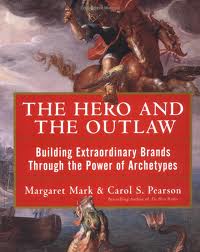The Hero and the Outlaw: Building Extraordinary Brands Through the Power of Archetypes

– By Margaret Mark & Carol S. Pearson
Wikipedia defines an archetype as a universally understood symbol, term, statement, or pattern of behavior, a prototype upon which others are copied, patterned, or emulated. Archetypes are often used in myths and storytelling across different cultures. In psychology, an archetype is a model of a person, personality, or behavior. Carl Jung, the eminent psychotherapist and psychiatrist, developed the concept of archetypes and how they could be used to describe personalities.
We all talk of brand personalities and brand identities and if we look closely at many of them, they could fit into an archetype. In their book – The Hero and the Outlaw – Margaret Mark and Carol S. Pearson write that ‘for a brand identity to be compelling, it needs to be simple and easy to recognize. This means that brand identities are forged best by identifying with one – and only one – archetype. This archetype within the brand serves as a beacon for the corresponding motivation in all of us.’
Archetypes provide a meaning to brands that is fairly easy to remember. And because they are very definite, they help us identify the dynamics of a category and thus differentiate our brand from others in the category. More importantly, archetypes ‘provide the link between consumer motivation and product sales. Virtually all marketers know that they need to understand human motivations. Until now, however, no scientific method has been available to link the deepest motivations of consumers with product meaning. The missing link is the understanding of archetypes. An archetypical product identity speaks directly to the deep psychic imprint within the consumer, sparking a sense of recognition and of meaning.’
In the Hero and the Outlaw, Mark and Pearson examine 12 of the most common archetypes and these are described below:
- The Innocent
Core desire: To experience paradise
Goal: To be happy
Brands: Coca Cola, McDonald’s, Ivory
- The Explorer
Core desire: The freedom to find out who you are through exploring the world
Goal: To experience a better, more authentic, more fulfilling life
Brands: Ford Explorer, Starbucks, Rockport
- The Sage
Core desire: The discovery of truth
Goal: To use intelligence and analysis to understand the world
Brands: Barnes & Nobles, Lean Cuisine, CNN
- The Hero
Core desire: Prove one’s worth through courageous and difficult action
Goal: Exert mastery in a way that improves the world
Brands: Nike, FedEx, the Red Cross, the Olympics
- The Outlaw
Core desire: Revenge or revolution
Goal: To destroy what is not working (for the outlaw or the society)
Brands: Apple, Diesel, Harley-Davidson
- The Magician
Core desire: Knowledge of the fundamental laws of how the world or universe works
Goal: Make dreams come true
Brands: MasterCard, Chanel No.5, Oil of Olay
- The Regular Guy/Girl
Core desire: Connection with others
Goal: To belong, fit in
Brands: IKEA, Wendy’s, Impulse
- The Lover
Core desire: Attain intimacy and experience sensual pleasure
Goal: Being in a relationship with the people, work, experiences and relationships one loves
Brands: Hennessy, Godiva, Jaguar, Guess Jeans
- The Jester
Core desire: To live in the moment with full enjoyment
Goal: To have a great time and lighten up the world
Brands: Pepsi, Snickers, Hampton Inn
- The Caregiver
Core desire: Protect people from harm
Goal: To help others
Brands: AT & T, Johnson’s Baby Shampoo, Marriott
- The Creator
Core desire: Create something of enduring value
Goal: Give form to a vision
Brands: Sesame Street, Lego, Crayola
- The Ruler
Core desire: Control
Goal: Create a prosperous, successful, family, company or community
Brands: Microsoft, Mercedes, American Express
The Hero and the Outlaw does provide an interesting framework and one could look at fitting one’s brand into one of the 12 archetypes. Following the archetypical model also allows for a clear universe in which your brand could operate. However, the book does suffer from a major shortcoming – while the examples in the book against each archetype looks meaningful, it could also be more of a retro fit. Also, a brand like, say, Coke, could fit into many of the archetypes in the book, not just the Innocent. However, understanding artcetypes would come useful to marketers and advertising executives and, for that reason, the book is worth a read.
4/5
